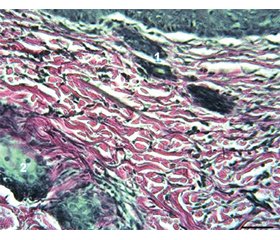Журнал «Медицина неотложных состояний» Том 20, №6, 2024
Вернуться к номеру
Загоєння хронічних ран на стадії ремоделювання: співвідношення гормональних та імунних показників
Авторы: Павлов С.Б. (1), Бабенко Н.М. (1), Кумечко М.В. (1), Літвінова О.Б. (1), Комарчук Є.В. (2), Кудревич І.О. (1)
(1) - Харківський національний медичний університет, м. Харків, Україна
(2) - Харківський національний університет імені В.Н. Каразіна, м. Харків, Україна
Рубрики: Медицина неотложных состояний
Разделы: Клинические исследования
Версия для печати
Актуальність. Негативні наслідки хронічних ран відчувають як пацієнти, так і системи охорони здоров’я всього світу. Хронічні рани часто передують серйозним подіям, як-от ампутація кінцівок і передчасна смерть. Мета: вивчення співвідношення ендокринних факторів (інсулін і кортизол) та біоактивних молекул (інтерферон-γ (IFN-γ) і трансформуючий фактор росту β1 (TGF-β1)), що впливають на розвиток репаративних процесів хронічних ран на стадії ремоделювання в експерименті, а також аналіз особливостей гістоструктури шкіри щура в ділянці загоєння хронічної рани. Матеріали та методи. Дослідження було проведено на 12 білих щурах. Тварини були рандомізовані на інтактну та експериментальну групи по 6 тварин у кожній. Щурам експериментальної групи були індуковані хронічні рани. Евтаназію тварин здійснювали на 28-му добу експерименту. У сироватці крові методом імуноферментного аналізу визначали рівні інсуліну, кортизолу, IFN-γ та TGF-β1. Гістологічне дослідження проведено за допомогою загальноприйнятих методів. Результати. Було показано, що концентрації інсуліну, кортизолу та TGF-β1 у тварин експериментальної групи були збільшені майже вдвічі порівняно з інтактними тваринами. Рівень IFN-γ у щурів із ранами був у 1,2 раза нижчим, ніж у інтактних щурів. Мікроскопічне дослідження показало, що рани перебувають на стадії ремоделювання. При цьому частково зберігаються ознаки запалення, що може свідчити про хронізацію репаративного процесу. Висновки. Розуміння механізмів розвитку репаративних процесів при загоєнні ран дозволить розробити клінічні протоколи для поліпшення допомоги пацієнтам із травмами.
Background. Both patients and healthcare systems around the world experience the negative consequences of chronic wounds. Chronic wounds often precede serious events such as amputation and premature death. Objective: to study the relationship between endocrine factors (insulin and cortisol) and bioactive molecules (interferon-γ (IFN-γ) and transforming growth factor-β1 (TGF-β1)), influencing the development of reparative processes of chronic wounds at the remodeling stage in an experiment, and to analyze the features of the histostructure of rat skin in the area of chronic wound healing. Materials and methods. The study was conducted on 12 white rats. Animals were randomized into intact and experimental groups, with 6 participants in each group. Chronic wounds were induced in the experimental group. Rats were euthanized on the 28th day of the experiment. In the blood serum, the insulin, cortisol, IFN-γ, and TGF-β1 levels were determined by enzyme immunoassay. Histological examination was carried out using generally accepted methods. Results. It was shown that the concentrations of insulin, cortisol, and TGF-β1 in animals of the experimental group were almost doubled compared to intact rats. The level of IFN-γ in animals with wounds was 1.2 times lower than in intact rats. Microscopic examination showed that the wounds were at the stage of remodeling. At the same time, signs of inflammation are partially preserved, which may indicate chronicity of the reparative process. Conclusions. Understanding the mechanisms of reparative processes during wound healing will allow for the development of clinical protocols to improve care for patients with injuries.
хронічна рана; репаративні процеси; інсулін; кортизол; цитокіни; експеримент
chronic wound; reparative processes; insulin; cortisol; cytokines; experiment
Для ознакомления с полным содержанием статьи необходимо оформить подписку на журнал.
- Tan MLL, Chin JS, Madden L, Becker DL. Challenges faced in developing an ideal chronic wound mo-
- del. Expert Opin Drug Discov. 2023 Jan;18(1):99-114. doi: 10.1080/17460441.2023.2158809.
- Sen CK. Human Wound and Its Burden: Updated 2020 Compendium of Estimates. Adv Wound Care (New Rochelle). 2021 May;10(5):281-292. doi: 10.1089/wound.2021.0026.
- Babenko NM, Litvinova OB, Pavlov SB, et al. Problems of healing chronic wounds. Modern Medical Technology. 2023;3:66-70. doi: 10.34287/MMT.3(58).2023.10.
- Lurin IA, Khomenko IP, Nehoduiko VV, et al. Prospects of the high-speed multimedia data transmission technologies use in the structure of the system for providing aid to injured persons having a gunshot defect of soft tissues. Wiad Lek. 2023;76(5 pt 2):1191-1198. doi: 10.36740/WLek202305209.
- Pavlov S, Babenko N, Kumetchko M, et al. Features of metabolism in chronic wound remodelling. Scr Med. 2024 Jan-Feb;55(1):53-61. doi: 10.5937/scriptamed55-48179.
- Jin R, Luo L, Zheng J. The Trinity of Skin: Skin Homeostasis as a Neuro-Endocrine-Immune Organ. Life (Basel). 2022 May 12;12(5):725. doi: 10.3390/life12050725.
- Aher S, Waknis P, Shah S, et al. Evaluation of Presurgical Serum Cortisol Level in Patients Undergoing Major Maxillofacial Surgery. Ann Maxillofac Surg. 2020 Jan-Jun;10(1):25-30. doi: 10.4103/ams.ams_20_19.
- Gong S, Miao YL, Jiao GZ, et al. Dynamics and correlation of serum cortisol and corticosterone under different physiological or stressful conditions in mice. PLoS One. 2015 Feb 20;10(2):e0117503. doi: 10.1371/journal.pone.0117503.
- Ostróżka-Cieślik A, Przybyła M, Wójcik W, et al. Review of Research in Developing Hydrogels with Insulin to Promote Wound Healing. Med Sci Forum. 2023;21(1):17. doi: 10.3390/ECB2023-14290.
- Pavlov SB, Tamm TI, Komisova TY, et al. The nature of changes in endocrine and immune factors at the initial stage of the formation of chronic wounds. Modern Medical Technology. 2023;2:34-9. doi: 10.34287/MMT.2(57).2023.6.
- Kaur P, Choudhury D. Insulin Promotes Wound Healing by Inactivating NFkβP50/P65 and Activating Protein and Lipid Biosynthesis and alternating Pro/Anti-inflammatory Cytokines Dynamics. Biomol Concepts. 2019 Feb 22;10(1):11-24. doi: 10.1515/bmc-2019-0002.
- Kanno E, Tanno H, Masaki A, et al. Defect of Interferon γ Leads to Impaired Wound Healing through Prolonged Neutrophilic Inflammatory Response and Enhanced MMP-2 Activation. Int J Mol Sci. 2019 Nov 12;20(22):5657. doi: 10.3390/ijms20225657.
- Kiritsi D, Nyström A. The role of TGFβ in wound healing pathologies. Mech Ageing Dev. 2018 Jun;172:51-58. doi: 10.1016/j.mad.2017.11.004.
- Morikawa M, Derynck R, Miyazono K. TGF-β and the TGF-β Family: Context-Dependent Roles in Cell and Tissue Physiology. Cold Spring Harb Perspect Biol. 2016 May 2;8(5):a021873. doi: 10.1101/cshperspect.a021873.
- Wang L, Qin W, Zhou Y, et al. Transforming growth factor β plays an important role in enhancing wound healing by topical application of Povidone-iodine. Sci Rep. 2017 Apr 20;7(1):991. doi: 10.1038/s41598-017-01116-5.

